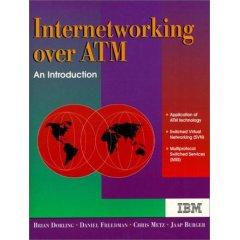| 2020ok Directory of FREE Online Books and FREE eBooks |
Free eBooks > Computers & Internet > Networking > Networks, Protocols & API's > ISDN > Internetworking over ATM: An Introduction
Internetworking over ATM: An Introductionby Ibm  Download Book (Respecting the intellectual property of others is utmost important to us, we make every effort to make sure we only link to legitimate sites, such as those sites owned by authors and publishers. If you have any questions about these links, please contact us.) link 1 About Book From the Inside Flap For the foreseeable future a significant percentage of devices using an ATM network will do so indirectly, and will continue to be directly attached to “legacy” media (such as Ethernet and token ring). In addition these devices will continue to utilize “legacy” internetwork layer protocols (for example, IP, IPX, APPN, etc). This means that in order to effectively use ATM, there must be efficient methods available for operating multiple internetwork layer protocols over heterogeneous networks built from switches, routers, and other switched devices. This challenge is commonly referred to as the operation of multiprotocol over ATM. This book reviews the various options for the transport and support of multiple protocols over ATM. This book was written for networking consultants, systems specialists, system planners, network designers and network administrators who need to learn about SVN and associated protocols in order to design and deploy networks that utilize components from this framework. It provides readers with the ability to differentiate between the different offerings. A working knowledge of ATM is assumed. It is intended to be used with High-Speed Networking Technology: An Introductory Survey, which describes methods for data transmission in high speed networks, and Asynchronous Transport Mode (ATM) Technical Overview, which describes ATM, a link-level protocol using the methods described in High-Speed Networking Technology: An Introductory Survey to transmit various types of data together over the same physical links. This book describes the networking protocols that use ATM as the underlying link level protocol. From the Back Cover
Today's networking environment is characterized by a diverse mix of topologies, geographic spans, carrier services, equipment, interfaces, physical media, and transmission speeds. Because of the inherent complexity resulting from mixed technologies, it becomes extremely difficult to satisfy all these requirements with existing networking tools. For example, in order for an Ethernet-attached client in a branch office to access an FDDI-attached server in a different location, at least three different networking protocols must be made to communicate. Asynchronous transfer mode (ATM) provides the foundation for technology that will not only provide the desired simplification, but will also support those emerging applications that will demand end-to-end quality of service and bandwidth reservation capability. Internetworking Over ATM provides an over view of protocols and technologies that enable “legacy†networking protocols (such as IP and APPN) to use ATM networks. The book explains the challenges involved in using ATM networks and the limitations of legacy protocols in ATM networks, and compares several solutions. Features of Internetworking Over ATM:
Internetworking Over ATM was written as a “redbook†at IBM's International Technical Support Center in Raleigh, North Carolina. The IBM International Technical Support Organization (ITSO) was set up to provide a link between IBM development and IBM engineers working in the field, enabling them to work with new products and systems under development. This is one of the main ways within IBM for keeping technically skilled people up to date with new technologies. It also means new products are given a workout by field practitioners before they are released to customers, thus improving product quality. Redbooks are IBM publications produced by the ITSO. Most of these are very practical guides to current solutions, but some have a much wider focus and are intended to educate people about the current technologies. Because they are written largely by people with extensive practical experience, they offer a much more direct and problem-solving approach than many books on similar topics. Excerpt. © Reprinted by permission. All rights reserved. For the foreseeable future a significant percentage of devices using an ATM network will do so indirectly, and will continue to be directly attached to “legacy” media (such as Ethernet and token ring). In addition these devices will continue to utilize “legacy” internetwork layer protocols (for example, IP, IPX, APPN, etc). This means that in order to effectively use ATM, there must be efficient methods available for operating multiple internetwork layer protocols over heterogeneous networks built from switches, routers, and other switched devices. This challenge is commonly referred to as the operation of multiprotocol over ATM. This book reviews the various options for the transport and support of multiple protocols over ATM. This book was written for networking consultants, systems specialists, system planners, network designers and network administrators who need to learn about SVN and associated protocols in order to design and deploy networks that utilize components from this framework. It provides readers with the ability to differentiate between the different offerings. A working knowledge of ATM is assumed. It is intended to be used with High-Speed Networking Technology: An Introductory Survey, which describes methods for data transmission in high speed networks, and Asynchronous Transport Mode (ATM) Technical Overview, which describes ATM, a link-level protocol using the methods described in High-Speed Networking Technology: An Introductory Survey to transmit various types of data together over the same physical links. This book describes the networking protocols that use ATM as the underlying link level protocol. Related Free eBooks
| Related Tags |












Saggy,Indore,MP, 2008-05-23 15:00:51
SEND A COMMENT
PLEASE READ: All comments must be approved before appearing in the thread; time and space constraints prevent all comments from appearing. We will only approve comments that are directly related to the article, use appropriate language and are not attacking the comments of others.